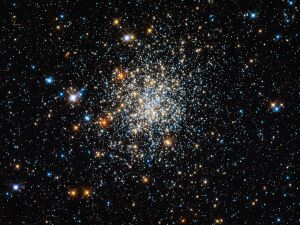Astronomy:NGC 411
| NGC 411 | |
|---|---|
 | |
| Observation data (J2000 epoch) | |
| Constellation | Tucana |
| Right ascension | 01h 07m 55.95s[1] |
| Declination | −71° 46′ 04.5″[1] |
| Distance | 179,000 ± 13,000 ly (55,000 ± 4,000 pc)[2] |
| Apparent magnitude (V) | 12.1[1] |
| Apparent dimensions (V) | 2.1′ × 1.9′[1] |
| Physical characteristics | |
| Mass | 3.0×104[3] M☉ |
| Estimated age | 1.5 billion years[4] |
| Other designations | Kron 60, Lindsay 82, ESO 51-19[1] |
NGC 411 is a globular cluster located approximately 55,000 pc (180,000 ly) from Earth in the constellation Tucana. It was discovered in 1826 by James Dunlop. It was described by Dreyer as "extremely faint, pretty large, round, gradually very little brighter middle".[5] At a distance of about 180,000 light years (55,000 parsecs), it is located within the Small Magellanic Cloud.[2] It has a mass of about 3.0×104 M☉, and a luminosity of about 8.0×104 L☉.[3]
NGC 411 was imaged by the Hubble Space Telescope in 2013, showing an abundance of stars ranging from blue to red.[6] In particular, this seemed to suggest that the cluster was much younger than previously thought: its age has been estimated at 1.5 billion years old, relatively young in astronomical terms.[4][6] However, these results have been challenged by another group who state that these young stars may actually just be background stars, and are thus physically unrelated.[7]
References
- ↑ 1.0 1.1 1.2 1.3 1.4 "NGC 411". SIMBAD. Centre de données astronomiques de Strasbourg. http://simbad.u-strasbg.fr/simbad/sim-basic?Ident=NGC+411.
- ↑ 2.0 2.1 "NASA/IPAC Extragalactic Database". Results for NGC 0411. http://ned.ipac.caltech.edu/cgi-bin/objsearch?objname=NGC+411&extend=no&hconst=73&omegam=0.27&omegav=0.73&corr_z=1&out_csys=Equatorial&out_equinox=J2000.0&obj_sort=RA+or+Longitude&of=pre_text&zv_breaker=30000.0&list_limit=5&img_stamp=YES.
- ↑ 3.0 3.1 Song, Ying-Yi; Mateo, Mario; Bailey, John I.; Walker, Matthew G.; Roederer, Ian U.; Olszewski, Edward W.; Reiter, Megan; Kremin, Anthony (2021). "Dynamical masses and mass-to-light ratios of resolved massive star clusters – II. Results for 26 star clusters in the Magellanic Clouds". Monthly Notices of the Royal Astronomical Society 504 (3): 4160–4191. doi:10.1093/mnras/stab1065.
- ↑ 4.0 4.1 Li, C.; de Grijs, R.; Bastian, N.; Deng, L.; Niederhofer, F.; Zhang, C. (2016). "The tight subgiant branch of the intermediate-age star cluster NGC 411 implies a single-aged stellar population". Monthly Notices of the Royal Astronomical Society 461 (3): 3212–3221. doi:10.1093/mnras/stw1491. Bibcode: 2016MNRAS.461.3212L.
- ↑ "New General Catalog Objects: NGC 400 - 449". Cseligman. http://cseligman.com/text/atlas/ngc4.htm#411.
- ↑ 6.0 6.1 "Hubble Finds Appearances can be Deceptive". 2013. https://www.nasa.gov/mission_pages/hubble/science/ngc411.html.
- ↑ Cabrera-Ziri, I. (2016). "No evidence for younger stellar generations within the intermediate-age massive clusters NGC 1783, NGC 1806 and NGC 411". Monthly Notices of the Royal Astronomical Society 459 (4): 4218–4223. doi:10.1093/mnras/stw966. Bibcode: 2016MNRAS.459.4218C.
External links
 |

